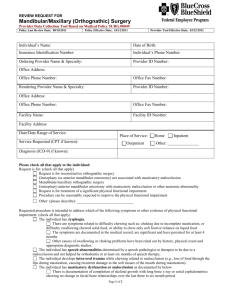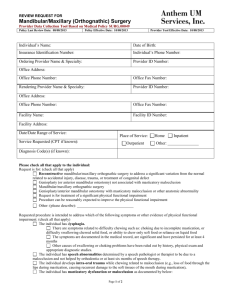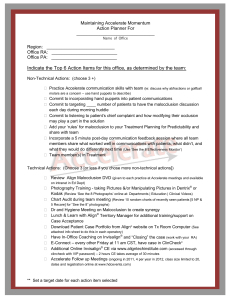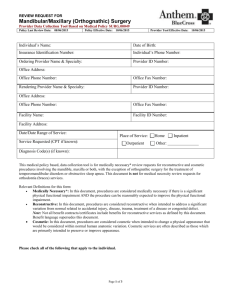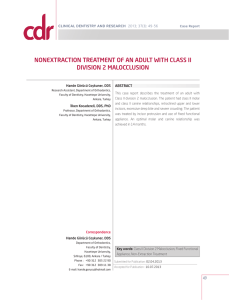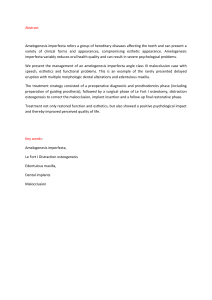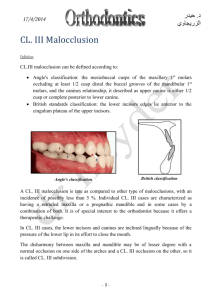comparative dentoskeletal study of class ii division 1 and class ii
advertisement
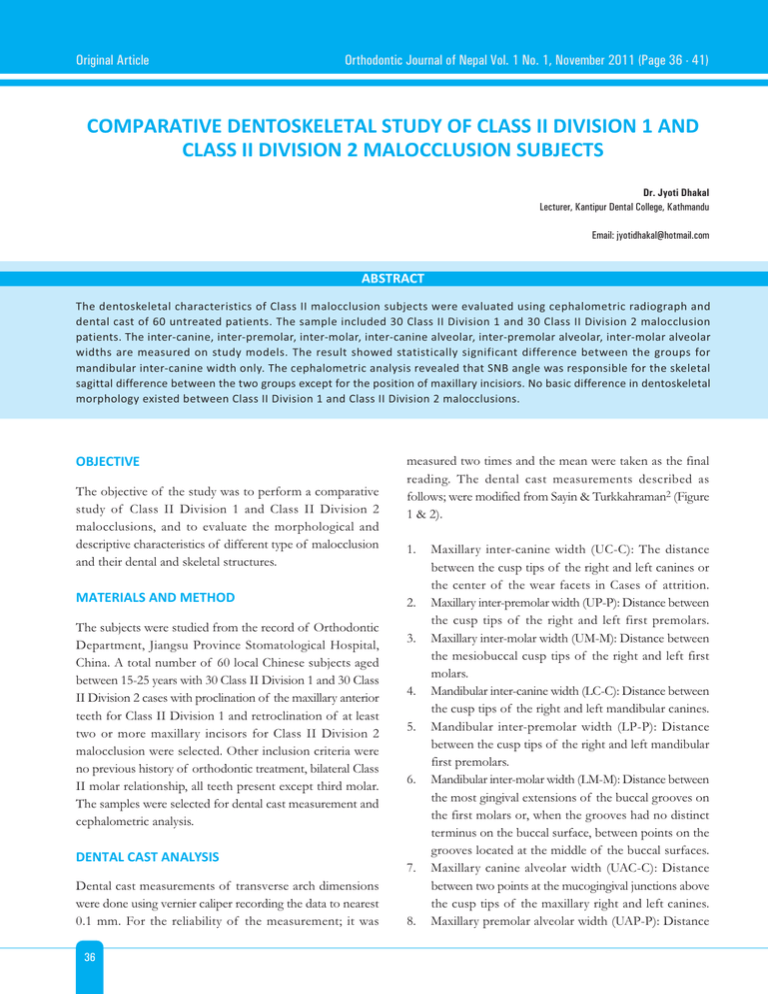
Original Article Orthodontic Journal of Nepal Vol. 1 No. 1, November 2011 (Page 36 - 41) COMPARATIVE DENTOSKELETAL STUDY OF CLASS II DIVISION 1 AND CLASS II DIVISION 2 MALOCCLUSION SUBJECTS Dr. Jyoti Dhakal Lecturer, Kantipur Dental College, Kathmandu Email: jyotidhakal@hotmail.com ABSTRACT The dentoskeletal characteristics of Class II malocclusion subjects were evaluated using cephalometric radiograph and dental cast of 60 untreated patients. The sample included 30 Class II Division 1 and 30 Class II Division 2 malocclusion patients. The inter-canine, inter-premolar, inter-molar, inter-canine alveolar, inter-premolar alveolar, inter-molar alveolar widths are measured on study models. The result showed statistically significant difference between the groups for mandibular inter-canine width only. The cephalometric analysis revealed that SNB angle was responsible for the skeletal sagittal difference between the two groups except for the position of maxillary incisiors. No basic difference in dentoskeletal morphology existed between Class II Division 1 and Class II Division 2 malocclusions. OBJECTIVE The objective of the study was to perform a comparative study of Class II Division 1 and Class II Division 2 malocclusions, and to evaluate the morphological and descriptive characteristics of different type of malocclusion and their dental and skeletal structures. MATERIALS AND METHOD The subjects were studied from the record of Orthodontic Department, Jiangsu Province Stomatological Hospital, China. A total number of 60 local Chinese subjects aged between 15-25 years with 30 Class II Division 1 and 30 Class II Division 2 cases with proclination of the maxillary anterior teeth for Class II Division 1 and retroclination of at least two or more maxillary incisors for Class II Division 2 malocclusion were selected. Other inclusion criteria were no previous history of orthodontic treatment, bilateral Class II molar relationship, all teeth present except third molar. The samples were selected for dental cast measurement and cephalometric analysis. DENTAL CAST ANALYSIS Dental cast measurements of transverse arch dimensions were done using vernier caliper recording the data to nearest 0.1 mm. For the reliability of the measurement; it was 36 measured two times and the mean were taken as the final reading. The dental cast measurements described as follows; were modified from Sayin & Turkkahraman2 (Figure 1 & 2). 1. 2. 3. 4. 5. 6. 7. 8. Maxillary inter-canine width (UC-C): The distance between the cusp tips of the right and left canines or the center of the wear facets in Cases of attrition. Maxillary inter-premolar width (UP-P): Distance between the cusp tips of the right and left first premolars. Maxillary inter-molar width (UM-M): Distance between the mesiobuccal cusp tips of the right and left first molars. Mandibular inter-canine width (LC-C): Distance between the cusp tips of the right and left mandibular canines. Mandibular inter-premolar width (LP-P): Distance between the cusp tips of the right and left mandibular first premolars. Mandibular inter-molar width (LM-M): Distance between the most gingival extensions of the buccal grooves on the first molars or, when the grooves had no distinct terminus on the buccal surface, between points on the grooves located at the middle of the buccal surfaces. Maxillary canine alveolar width (UAC-C): Distance between two points at the mucogingival junctions above the cusp tips of the maxillary right and left canines. Maxillary premolar alveolar width (UAP-P): Distance between two points at the mucogingival junctions above the interdental contact point of the maxillary first and second premolars. 9. Maxillary molar alveolar width (UAM-M): Distance between two points at the mucogingival junctions above the mesiobuccal cusp tips of the maxillary first molars 10. Mandibular canine alveolar width (LAC-C): The projection of UAC-C point in the lower jaw 11. Mandibular premolar alveolar width (LAP-P): The projection of UAP-P point in the lower jaw 12. Mandibular molar alveolar width (LAM-M): The projection of UAM-M point in the lower jaw CEPHALOMETRIC ANALYSIS cephalometric and dental landmarks used are illustrated in Figure 3 and skeletal & dental line and angle projections are illustrated in Figure 4. Twelve arch width measurements were recorded and eleven cephalometric radiograph analyses were used. All statistical calculations were performed with Microsoft Excel. In addition, standard descriptive statistics (mean and standard deviation) and sample t-test were carried out in order to allow comparison of the malocclusion groups. The Minitab software was used to calculate the t-test. Independent sample t-test was applied for comparison of the groups. RESULT The same subjects with the given inclusion criteria were subjected to cephalometric analysis. Lateral cephalometric radiographs were analyzed with NJMU software. The Dental cast analysis: Comparison of the dental arch widths of Class II Division 1 and Class II Division 2 malocclusions are shown in Table 1 and 2. Out of twelve transverse measurements, only three measurements showed statistically Figure 1 Maxillary dental cast measurement Figure 3 Skeletal & dental landmarks used for cephalometric analysis Figure 2 Mandibular dental cast measurement Figure 4 Skeletal & dental line and angle projections used for cephalometric analysis 37 significant difference. Mean maxillary inter-premolar value is more in Class II Division 1 malocclusion as compared to Class II Division 2. Whereas, while comparing the maxillary inter-premolar alveolar width; Class II Division 2 malocclusion showed more value with significant difference. For molar transverse width and molar alveolar transverse width showed almost similar values. Mean value for Class II Division 2 inter-canine widths of mandible were smaller than Class II Division 1 malocclusion with statistically significant differences. CEPHALOMETRIC ANALYSIS Skeletal parameters: Skeletal angular cephalometric comparisons of Class II Division 1 and Class II Division 2 malocclusion samples are presented in Table 3. SNA value for Class II Division 1 malocclusion is larger than Class II Division 2 without any significant difference. SNB value for Class II Division 1 malocclusion is larger than the Class II Division 2 with statistically significant difference. ANB angle; which indicates the relative position of the maxilla to the mandible shows almost similar values. According to the study; ANP-FH is smaller for Class II Division 2 malocclusion and Y-axis does not show any statistically significant differences between Class II Division 1 and Class II Division 2 malocclusion samples. Dental parameters: UI-SN angle is more for the Class II Division 1 malocclusion than the Class II Division 2. Cephalometric analysis of UI-LI shows more value for Class II Division 2 malocclusion with highly significant value. LIMP value is more in Class II Division 1 malocclusion than in Class II Division 2 samples. UI-NA (mm) value for Class II Division 1 malocclusion is greater than Class II Division 2 with highly significant differences, which indicates more prognathic maxillary incisor for Class II Division 1 malocclusion. LI-NB (mm) value for the Class II Division 1 malocclusion is greater than Class II Division 2 malocclusion samples. Table 1: Descriptive statistics and statistical comparison of dental and alveolar widths of maxillary Class II Division 1 and Class II Division 2 malocclusion samples Class II Div I Cast Standard Mean Deviation Inter-canine Inter-premolar Inter-molar Inter-canine alv Inter-premolar alv Inter-molar alv 31.82 41.66 52.4 37.53 47.75 60.38 4.3 3.07 3.13 4.67 5.13 3.94 MAXILLA Class II Div II Cast Standard Mean Deviation 33.33 39.66 50.79 38.25 50.27 59.96 5.14 3.29 5.93 3.18 3.8 5.56 T-test t-value v-value -1.68 2.43 1.32 -0.7 -2.42 0.34 0.099(NS) 0.018 0.195(NS) 0.488(NS) 0.019 0.737(NS) Table 2: Descriptive statistics and statistical comparison of dental and alveolar widths of mandibular Class II Division 1 and Class II Division 2 malocclusion samples Class II Div I Cast Standard Mean Deviation MANDIBLE Class II Div II Cast Standard Mean Deviation T-test t-value v-value Inter-canine 28.14 2.38 26.83 2.18 -1 0.021 Inter-premolar 33.9 5.33 33.15 3.03 0.67 0.506(NS) Inter-molar 45.56 4.31 45.48 4.57 0.07 0.945(NS) Inter-canine alv 28.53 3.5 28.79 2.8 -0.32 0.752(NS) Inter-premolar alv 39.33 4.35 42.71 4.29 -2.14 0.528(NS) Inter-molar alv 56.41 3.95 55.121 6.91 0.89 0.379(NS) 38 Table 3: Statistics and statistical cephalometric comparison of Class II Division 1 and Class II Division 2 malocclusion samples (Skeletal parameters) Class II Div I Cast Standard Mean Deviation MAXILLA Class II Div II Cast Standard Mean Deviation T-test t-value v-value SNA SNB ANB NP-FH 82.16 77.7 4.28 83.96 3.51 3.94 2.6 3.74 80.7 75.22 5.48 82.01 3.89 3.95 2.81 4.45 -1.53 -2.43 1.71 -1.89 0.132 (NS) 0.018 0.093 (NS) 0.064 (NS) FH-MP Y-AXIS 25.86 66.7 4.82 5.22 27.24 66.36 5.19 4.22 1.07 -0.28 0.29 (NS) 0.783 (NS) Table 4: Statistics and statistical cephalometric comparison of Class II Division 1 and Class II Division 2 malocclusion samples (Dental parameters) Class II Div I Cast Standard Mean Deviation UL-LI UI-SN LI-MP 111.6 115.63 98.64 MAXILLA Class II Div II Cast Standard Mean Deviation 9.42 7.33 7.96 140.9 87.77 89.328 13.43 17.78 18.26 T-test t-value v-value 9.78 -7.18 -2.56 0 0 0.014 Table 5: Statistics and statistical cephalometric comparison of Class II Division 1 and Class II Division 2 malocclusion samples (Linear parameters) Class II Div I Cast Standard Mean Deviation UI-NA (mm) LI-NB (mm) 8.69 7.31 MAXILLA Class II Div II Cast Standard Mean Deviation 3.53 3.34 DISCUSSION Clinicians speculate that nasal obstruction, digit habit, tongue thrusting, low tongue position, abnormal swallowing and sucking habit are the reasons for narrow maxillary dental arch width in Class II Division 1 malocclusion. Staley et al 7 stated that maxillary dental arch width of Class II Division 1 is narrower as compared to maxillary dental arch width of normal occlusion samples. According to the result for maxillary arch; the statistically significant differences among the groups were found in the maxillary inter-premolar width and inter-premolar alveolar width. But the different result in molar width between Class II Division 1 and Division 0.75 3.55 4.62 2.51 T-test t-value v-value -7.47 -4.92 0 0 2 has been noted. Maxillary inter-premolar width, all maxillary alveolar widths, mandibular premolar width and molar alveolar widths were significantly narrower in the Class II Division 1 group when compared to the normal occlusion sample reported by Uysal and Memili.4 The present result showed constriction of the mandibular inter-canine distance in Class II Division 2 subjects. It is suggested that Class II Division 2 malocclusion is characterized by normal transverse dimensions in the maxillary and mandibular posterior segment but reduced inter-canine arch dimension in the mandible.11,13 A possible explanation of this phenomenon might be the extreme deep bite in 39 patients with Class II Division 2 samples that inhibit anterior development of the mandibular dentoalveolar segment. The mandibular incisors could be compressed by the lack of available space resulting from a forward growth rotation of the mandible. Thus, mandibular anterior crowding and dentoalveolar extrusion are possible sequelae to the mandibular inter-canine width constriction.19,13 Another view could be based on the nature of holding cusps in stabilizing the arch form and tooth position over time; molars and premolars meet their antagonists naturally in a solid, interlocking occlusion; but the canines and the incisors do not have this advantage and thus would be more likely to shift the position in time. Walkow and Peck13 indicated that mandibular canine width was significantly less in Class II Division 2 deep bite patients and suggested that the extreme deep bite may inhibit anterior development of the mandibular dentoalveolar segment. The result shows that the SNA angle which indicates maxillary sagittal position are similar while comparing Class II Division 1 and Division 2 malocclusions, which are in agreement with previously published studies.2 SNB angle indicates the sagittal position of the mandible shows retrognathic mandible for both Class II Division 1 and Division 2 malocclusions.5 According to the present findings; SNB value for Class II Division 2 is lesser than the Class II Division 1 sample. The mandibular sagittal position of Class II Division 2 is more retruded than the Class II Division 1 malocclusion. This result may be possibly due to the retroclined maxillary incisors combined with the deep bite; thus the mandibular growth was restricted in Class II Division 2 samples. The most evident dentoalveolar cephalometric characteristics of Class II Division 2 malocclusion is pronounced retroclination of the upper central incisors and an obtuse inter-incisal angle;2, 3 10 which are in full agreement with the present result. The inter-incisal angle for the Class II Division 2 malocclusion is greater than the Class II Division 1 malocclusion with statistically significant differences. The larger interincisal angle shows more retroclined position of the central incisors. 40 The mandibular incisors behave differently among two malocclusion samples. The angular measurement of the mandibular incisor LI-Mp present statistically significant difference; Class II Division 1 malocclusion showing more proclined lower incisors while Class II Division 2 showing more retroclined lower incisors. Value for Class II Division 1 is more than Class II Division 2 malocclusion;22 marked lower incisor retroclination in Class II Division 2 malocclusion is evident while on the other hand marked lower incisor proclination is present in Class II Division 1 malocclusion. In other studies relatively normal inclination22 and position29 of the mandibular incisiors were found in Class II Division 1 malocclusion. Also the linear measurement of lower incisor to NB point showed more value for Class II Division 1 malocclusion with significant differences. According to these results we can conclude that lower central incisors in Class II Division 1 are more proclined when compared to Class II Division 2 malocclusion. In Class II Division 2; the incisors are more retroclined in their apical bases. The similar result presented by Pancherz et al21 indicated the marked lower incisor retroclination of the mandibular central incisors. CONCLUSION While evaluating the dentoskeletal characteristics between Class II Division 1 and Class II Division 2 malocclusion subjects; the only statistically significant difference found from the study model measurements was mandibular intercanine width; which shows reduction of mandibular intercanine width in Class II Division 2 subjects. The cephalometric results revealed that SNB angle was responsible for the skeletal sagittal difference between the two groups. Dental parameters showed retroclined upper anterior teeth for Class II Division 2 and proclined anterior teeth for Class II Division 1 malocclusion. In conclusion, except for the position of the maxillary incisors, no basic difference in dentoskeletal morphology exists between Class II Division 1 and Class II Division 2 malocclusions. REFERENCES 1. 2. 3. 4. 5. 6. 7. 8. 9. 10. 11. 12. 13. 14. 15. 16. 17. 18. 19. 20. 21. 22. Lee RT. Arch width and form: a review. Am J Orthod Dentofacial Orthop. 1999; 115:305313 Sayin MO, TurkkahramanH. Comparison of dental arch and alveolar widths of patients with Class II Division 1 malocclusion and subjects with Class I ideal occlusion. AngleOrthod. 2004; 74:356360. Uysal T, Memili B, Usumez S, Sari Z. Dental and alveolar arch widths in normal occlusion, Class II Division 1 and Class II Division 2. Angle Orthod. 2005;75(6):756762. Fulya Isik, Didem Nalbantgil, Korkmaz Sayinsu and Tülin Arun A comparative study of cephalometric and arch width characteristics of Class II Division 1 and Division 2 malocclusions . The European Journal of Orthodontics 2006 28(2):179-183 Staley RN, Stuntz WR, Peterson LC. A comparison of arch widths in adults with normal occlusion and adults with Class II Division 1 malocclusion. Am J Orthod. 1985;88:163169. Napthali, Aron, Moshe H, Ariel D, Arieh D, Atalia W.pathognomonic cephalometric characteristics of angle Class II Division 2 malocclusion. Angle Orthod.2002; 72:251257. Walkow TM, Peck S. Dental arch width in Class II Divisionn2 deep-bite malocclusion. Am J Orthod Dentofacial Orthop. 2002; 122:608613. Pancherz H, Zieber K, Hoyer B. Cephalometric characteristics of Class II Division 1 and Class II Division 2 malocclusions: a comparative study in children. Angle Orthod. 1997; 67: 111-120. Garner LD, Butt MH. Malocclusion in black Americans and Nyeri Kenyans: an epidemiologic study. Angle Orthod 1985;55:139-4 Karlsen AT. Craniofacial characteristics in children with Angle Class II Division 2 malocclusion combined with extreme deep bite. Angle Orthod. 1994;64:123130. Walkow TM, Peck S. Dental arch width in Class II Divisionn2 deep-bite malocclusion. Am J Orthod Dentofacial Orthop. 2002;122:608613. Staley RN, Stuntz WR, Peterson LC. A comparison of arch widths in adults with normal occlusion and adults with Class II Division 1 malocclusion. Am J Orthod. 1985;88:16316923. Walkow TM, Peck S. Dental arch width in Class II Divisionn2 deep-bite malocclusion. Am J Orthod Dentofacial Orthop. 2002;122:608613. Baccetti T, Franchi L, McNamara JA Jr, Tollaro I. Early dentofacial features of Class II malocclusion: a longitudinal study from the deciduous through the mixed dentition. Am J Orthod Dentofacial Orthop. 1997;111:502509. Garner LD, Butt MH. Malocclusion in black Americans and Nyeri Kenyans: an epidemiologic study. Angle Orthod 1985;55:139-4 McNamara J A. Components of Class II malocclusion in children 8-10 years of age. Angle Orthod 1981; 51: 177-202. Craig C E. The skeletal pattern characteristic of Class I and Class II, Division 1 malocclusions in Norma Lateralis. Angle Orthod 1951; 21: 44-56. Drelich R C. A cephalometric study of untreated Class II, Division 1 Malocclusion. Angle Orthod 1948; 18: 70-75 Peck S, Peck L, Kataja M. Class II Division 2 malocclusion: Heritable pattern of small teeth in well-developed jaws. Angle Orthod 1998;68:917. Henry RG. A Classification of Class II Division 1 malocclusion. Angle Orthod. 1957; 27:8392. Pancherz H, Zieber K, Hoyer B. Cephalometric characteristics of Class II Division 1 and Class II Division 2 malocclusions: a comparative study in children. Angle Orthod 1997; 67: 111-120. Hitchcock H P. A cephalometric description of Class II Division 1 malocclusion. Am J Orthod 1973; 63: 414-4233929.Hedges RB. A cephalometric evaluation of Class II Division 2. Angle Orthod. 1958;28:191197. 41
